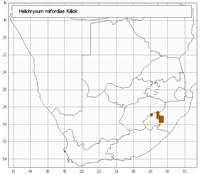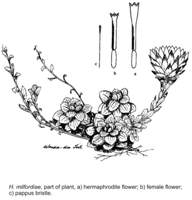Origin of name:
Named after Mrs Helen Milford who first collected the plant.
Diagnostic characters:
Plant 50--70 mm tallWhite bracts with maroon / brown tipsWoolly plantMat-forming
Description:
Prostrate mat-forming subshrub, old stems woody, gnarled, up to 8 mm in diam., young stems very slender (c. 1 mm diam.), stoloniferous, leafy, giving rise to innumerable congested leaf rosettes, flowering stems terminal, erect, up to 120 mm tall, closely leafy. Rosette leaves obovate to subspathulate, up to 14 x 9 mm, densely appressed silvery silky-woolly; cauline leaves similar but lanceolate to subspathulate, bracteate below the heads and tipped with a coloured scarious scale. Heads heterogamous, campanulate, c. 15 mm long, double that across the fully radiating bracts, solitary at the branch tips. Involucral bracts in c. 10 series, graded, loosely imbricate, much exceeding flowers, glossy white, mostly tipped crimson or dark brown. Receptacle very shortly honeycombed. Flowers 138�233, 18�29 female, 120�208 homogamous. Achenes 1.5 mm, glabrous. Pappus bristles many, equaling corolla, barbellate above, bases not cohering.
Flowers from late December to February.
Distribution:
Forming mats on rocks, or growing from cracks in cliff faces. Recorded only from the high Drakensberg on the KwaZulu-Natal-Lesotho border from Mont aux Sources and the Oxbow area to Sani Pass and Hodgson's Peaks, between 2 985 and 3 500 m.
Grassland Biome.
Taxonomy:
Literature:
Helichrysum milfordiae Killick in Bothalia 7: 414 (1960); Hilliard, Compositae in Natal 229 (1977).
Type:
KwaZulu-Natal, Bergville distr., Cathedral Peak Forest Station, top of Organ Pipes Pass, 9 700 ft, Killick 2322 (PRE, holo.; BM; K; M, iso.).
Synonym(s):
Vouchers:
Hilliard 5295 (E; K; M; NU; S); Nordenstam 2130 (NU); Wright 438 (E; K; NH; NU).


